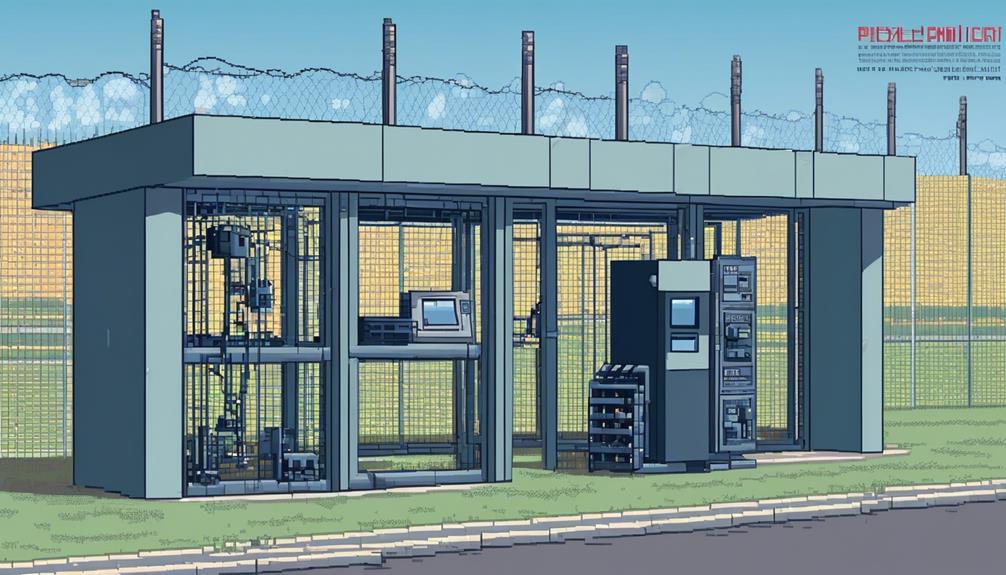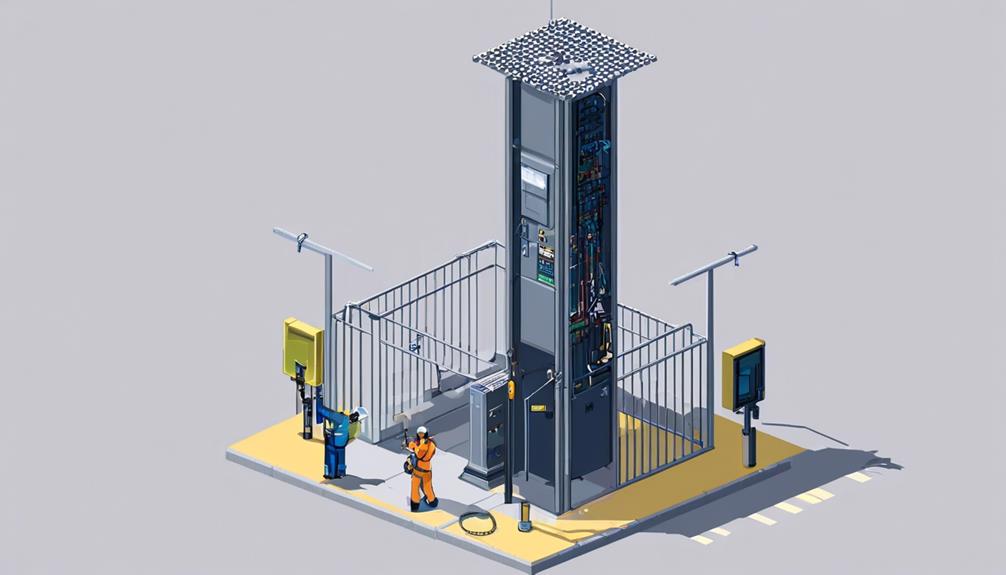Telecommunication shelters and enclosures play a crucial role in the seamless functioning of our modern communication networks. These structures provide a secure and controlled environment for critical field equipment, ensuring its protection against external elements and potential threats.
With advancements in technology, telecommunication shelters have evolved to incorporate features like lightweight construction, insulation, weather-tightness, and durability. Furthermore, their RF transparency enables the accommodation of multiple frequencies, ensuring reliable transmission and reception.
In this discussion, we will explore the importance of telecom shelters, the different types available, key features to consider, benefits of insulation, security measures, weather resistance considerations, best practices for installation, and maintenance tips for telecom enclosures.
By delving into these topics, we can gain a comprehensive understanding of the significance and intricacies surrounding telecommunication shelters and enclosures, ultimately enabling us to make informed decisions in this critical field.
Key Takeaways
- Telecom shelters and enclosures are essential for protecting critical field equipment from harsh weather conditions and ensuring reliable transmission and reception of telecommunications signals.
- These shelters are constructed using FiberBeam Technology, which provides a lightweight yet durable construction and accommodates multiple frequencies for maximum signal reach and reception.
- Telecom shelters can be customized to meet specific project requirements and come with a 25-year warranty.
- Security measures, such as access control systems, surveillance cameras, and alarm systems, should be implemented to protect telecom equipment from unauthorized access and potential threats. Data encryption, authentication, and protection from environmental hazards are also important considerations.
Importance of Telecom Shelters

The importance of telecom shelters lies in their ability to safeguard critical field equipment from harsh weather conditions, extreme temperatures, and moisture intrusion, ensuring reliable transmission and reception of telecommunications signals. These communication shelters are specifically designed to protect sensitive electronic equipment and ensure continuous communication in challenging environments.
Telecom shelters are constructed with exclusive FiberBeam Technology, which makes them lightweight yet highly durable. This technology also provides insulation and weather-tight properties, preventing any moisture intrusion that could potentially damage the equipment. The durability of these shelters allows them to be used in remote locations, ensuring long-term operation in harsh environmental conditions.
One major advantage of telecom shelters is their ability to accommodate multiple frequencies, allowing for maximum signal reach and reception. This makes them ideal for maintaining communication quality, even in areas with limited infrastructure. By providing a secure and controlled environment, telecom shelters ensure that critical field equipment remains operational and capable of transmitting and receiving telecommunications signals effectively.
Additionally, telecom shelters are tailored to meet unique project requirements. This involves collaboration with clients to determine precise specifications and ensure that the shelter meets their specific needs. This level of customization provides confidence and peace of mind to clients, as telecom shelters come with a 25-year warranty, guaranteeing their reliability and performance.
Types of Telecom Enclosures
Telecom enclosures come in various types, each designed to provide specific functionality and protection for critical field equipment. These enclosures are essential structures that house telecommunications, communications, and network equipment, protecting them from severe weather, extreme temperatures, moisture intrusion, and vandals.
Here are three types of telecom enclosures:
- Lightweight Design: These enclosures are ideal for hard-to-reach areas and rooftop installations. They are cost-effective for weight-restricted applications and transportation. Despite their lightweight construction, they are incredibly strong, weighing 70% less than steel and 25% less than aluminum. Pound for pound, they offer superior strength compared to steel, making them a reliable choice for protecting critical equipment.
- RF Transparency: Enclosures with proprietary wall construction reduce radio frequency interference, allowing for maximum signal reach and reception. They can accommodate multiple frequencies, ensuring reliable transmission and reception. These enclosures can also be designed with increased insulating materials without compromising RF transparency, making them suitable for maintaining communication quality.
- Durability in Remote Locations: Telecom enclosures placed in remote or challenging environments require durability and protection. Enclosures made from fiberglass offer excellent durability and longevity. They do not rust, corrode, or degrade over time, making them ideal for long-term use in outdoor environments. Fiberglass enclosures ensure equipment remains shielded from elements and security threats, providing reliable performance even in harsh conditions.
Key Features of Telecom Shelters

Featuring exclusive FiberBeam Technology, telecom shelters are constructed to be lightweight, insulated, weather-tight, durable, and secure. These key features make them an ideal choice for the telecommunications industry. Telecom shelters provide a reliable solution for various applications and are backed by an industry-leading 25-year warranty, ensuring their long-lasting performance.
One of the advantages of telecom shelters is their customization options. They can be tailored to meet specific project requirements, allowing for a seamless integration into any environment. This customization ensures that the shelter is optimized for its intended use, providing the necessary space and functionality for telecom equipment.
Maintenance is of utmost importance when it comes to telecom shelters. Regular inspections and upkeep are essential to ensure the continued performance and longevity of the shelter. This includes inspecting the insulation, checking for any signs of wear or damage, and cleaning the shelter to prevent the accumulation of dust and debris.
To protect the equipment housed within the shelter, there are a few tips to keep in mind. First, it is crucial to ensure proper grounding and surge protection to safeguard against electrical surges. Additionally, utilizing proper cable management techniques, such as organizing and securing cables, can help prevent damage and ensure efficient operation.
Benefits of Insulated Shelters
Insulated shelters offer a range of benefits that contribute to the safety, reliability, and longevity of critical field equipment in the telecommunications industry. These shelters provide several advantages over traditional shelters, including energy efficiency, customization options, and enhanced protection.
- Energy efficiency: Insulated shelters are designed with high-quality insulation materials that effectively regulate the internal temperature. This insulation helps to reduce heat transfer, minimizing the need for excessive heating or cooling. As a result, energy consumption is significantly reduced, leading to cost savings and improved overall efficiency.
- Customization options: Insulated shelters can be customized to meet the specific requirements of each project. This customization includes the ability to choose the size, layout, and configuration of the shelter. Additionally, various accessories such as racks, cabinets, and cable management systems can be incorporated to optimize the space and functionality. This level of customization ensures that the shelter is tailored to the unique needs of the telecom industry.
- Enhanced protection: Insulated shelters provide excellent protection against extreme temperatures, ensuring the safety and functionality of critical field equipment. The insulation materials used in these shelters effectively regulate the internal temperature, preventing equipment damage caused by overheating or freezing. This enhanced protection extends the lifespan of the equipment and reduces the risk of downtime or costly repairs.
Security Measures for Telecom Equipment

Implementing robust security measures is essential to safeguard telecom equipment from unauthorized access and potential threats. Telecom security solutions encompass a range of measures designed to protect the equipment, data, and communication channels within the telecom infrastructure.
Physical security measures play a crucial role in preventing unauthorized access. Strong physical barriers, such as fencing and locks, can deter intruders. Surveillance cameras can provide real-time monitoring and recording of any suspicious activities. Additionally, biometric access controls or keycard systems can restrict entry to authorized personnel only, ensuring that only those with proper credentials can access the telecom equipment.
Intrusion prevention is another important aspect of telecom security. Alarm systems and motion sensors can detect and deter potential intruders. These systems can trigger alerts, notifying security personnel or initiating automated responses to mitigate any potential threats.
Data encryption is a critical measure to protect sensitive information and communication channels within the telecom equipment. By encrypting data, it becomes unreadable to unauthorized individuals, ensuring the confidentiality and integrity of the information transmitted. Secure authentication protocols further enhance the security of communication channels, ensuring that only authorized parties can access the data.
To protect telecom equipment from environmental hazards, fire and flood detection systems should be implemented. These systems can detect and alert personnel in the event of a fire or flood, allowing for timely response and minimizing potential damage to the equipment.
Considerations for Weather-Resistant Shelters
To ensure the protection of telecommunications, communications, and network equipment from severe weather and extreme temperatures, it is crucial to consider various factors when selecting weather-resistant shelters. Telecom shelter design, weatherproofing techniques, and shelter maintenance play a significant role in ensuring the longevity and reliability of these structures.
Considerations for weather-resistant shelters include:
- Telecom Shelter Design: The design of the shelter is critical in withstanding harsh weather conditions. It should include features such as reinforced walls and roofs, proper insulation, and ventilation systems. The shelter should also be built with high-quality materials, such as heavy-duty steel or fiberglass, to ensure durability and resistance to corrosion.
- Weatherproofing Techniques: Weatherproofing techniques help protect the shelter from the elements. This includes applying weather-resistant coatings to the exterior walls, sealing all joints and openings to prevent water infiltration, and installing proper drainage systems to prevent water accumulation. Additionally, the shelter should be equipped with adequate insulation and HVAC systems to regulate temperature and humidity levels.
- Shelter Maintenance: Regular maintenance is essential to keep weather-resistant shelters in optimal condition. This includes inspecting the shelter for any signs of damage, such as cracks or leaks, and promptly addressing them. Regular cleaning of the shelter's exterior, including removing debris and vegetation, is also important to prevent potential damage or blockages.
Best Practices for Shelter Installation

When it comes to shelter installation, following best practices is crucial to ensure the longevity and functionality of the structure. Proper site preparation and foundation construction are essential to support the shelter's weight and withstand environmental conditions.
Additionally, adherence to manufacturer's guidelines is necessary to ensure proper assembly, weather-tight seals, and structural integrity.
Installation Tips
For optimal installation of telecommunication shelters and enclosures, it is crucial to carefully select a level and stable location to prevent any potential structural issues. Here are some installation tips to ensure the best performance and longevity of the shelters:
- Grounding and Lightning Protection: Implement proper grounding and lightning protection measures to safeguard the equipment from electrical surges and lightning strikes. This will help prevent damage and ensure the safety of the shelter and its contents.
- Climate Control Systems: Install effective ventilation systems, such as air conditioning and heating, to maintain the optimum temperature for equipment operation. This will help prevent overheating and ensure energy efficiency.
- Security Measures: Secure the shelter with appropriate locks and security systems to prevent unauthorized access and protect sensitive equipment. This will ensure the confidentiality and integrity of the telecommunications infrastructure.
Common Challenges
Common challenges in the installation of telecommunication shelters and enclosures require careful consideration and strategic planning to ensure the successful implementation of best practices. One of the common challenges is ensuring proper anchoring and foundation to withstand environmental forces during installation. This is crucial in areas prone to high winds, earthquakes, or flooding. Conducting thorough site surveys and assessments is another important aspect to identify potential installation difficulties and plan accordingly. Site limitations such as restricted access, uneven terrain, or limited space can pose challenges that need to be addressed. Implementing effective grounding and lightning protection systems is also crucial to safeguard the equipment and personnel. It is recommended to utilize professional installation teams with experience in telecom shelter installations to ensure quality workmanship and adherence to industry standards. Adhering to local building codes, regulations, and safety protocols is essential for compliance and safety during the installation process.
| Common Challenges in Shelter Installation | Best Practices |
|---|---|
| Proper anchoring and foundation | Conduct thorough site surveys and assessments |
| Environmental forces | Utilize professional installation teams |
| Site limitations | Implement effective grounding and lightning protection systems |
| Restricted access, uneven terrain, limited space | Adhere to local building codes, regulations, and safety protocols |
| Safeguarding equipment and personnel |
Maintenance and Upkeep of Telecom Enclosures
Maintaining and keeping telecom enclosures in optimal condition requires regular cleaning and inspections to remove dust and debris that can hinder equipment performance.
Additionally, preventive maintenance, such as testing and maintaining climate control systems, ensures the enclosures can withstand extreme temperatures and prolongs the lifespan of the equipment.
It is also crucial to regularly check and maintain security features to prevent unauthorized access and protect telecom equipment from vandalism or theft.
Cleaning and Inspections
Regular cleaning and inspections are crucial for ensuring the optimal functionality and longevity of telecom enclosures. These practices help prevent the buildup of debris, dust, and contaminants that can compromise equipment performance.
To effectively maintain and uphold the performance of telecom enclosures, the following practices should be implemented:
- Cleaning Frequency: Establish a regular cleaning schedule to remove dirt, dust, and debris from the enclosure. This can be done weekly, monthly, or as per the specific requirements of the environment.
- Inspection Checklist: Create a comprehensive checklist to inspect the enclosure thoroughly. This should include checking for any signs of equipment damage, loose connections, water leakage, or environmental wear.
- Equipment Performance: Regular inspections help identify potential issues that can impact equipment performance. By addressing these issues promptly, the reliability and security of the telecom infrastructure housed within the enclosures can be upheld.
Preventive Maintenance
To ensure the optimal performance and longevity of telecom enclosures, it is imperative to implement a comprehensive preventive maintenance plan. This plan should include regular inspections, cleaning, and upkeep of various components. A maintenance checklist can be used to ensure that all necessary tasks are completed on schedule. Troubleshooting techniques should also be incorporated to identify and address potential issues before they escalate. Equipment calibration is another critical aspect of preventive maintenance, ensuring that the telecom equipment operates at its highest efficiency. By implementing a preventive maintenance plan, telecom companies can minimize downtime, reduce repair costs, and extend the lifespan of their enclosures.
| Maintenance Checklist | Troubleshooting Techniques | Equipment Calibration |
|---|---|---|
| Regular inspections | Identifying potential issues | Calibrating equipment |
| Cleaning | Addressing problems before they escalate | Ensuring optimal efficiency |
| Environmental control maintenance | Resolving connectivity issues | Adjusting settings for accuracy |
| Power system upkeep | Ensuring uninterrupted operation | Testing and adjusting parameters |
Frequently Asked Questions
What Is a Telecommunications Enclosure?
A telecommunications enclosure refers to a protective structure utilized in the telecom industry to safeguard critical field equipment.
These enclosures are designed with advanced FiberBeam Technology, which ensures they are lightweight, insulated, weather-tight, durable, and secure.
They can be customized to meet specific project requirements and accommodate multiple frequencies for optimal signal reach and reception.
Telecommunications enclosures are crucial in ensuring reliable transmission and reception, particularly in hard-to-reach areas and rooftop installations.
When selecting a telecommunications enclosure, factors such as size, material, security features, and environmental conditions need to be considered.
What Size Are Telecom Shelters?
Telecom shelters come in various sizes to accommodate different project scopes and customer needs. These dimensions range from 6 feet by 8 feet to 12 feet by 28 feet.
When choosing a telecom shelter size, factors to consider include the project requirements, available space, and equipment that needs to be housed.
Different types of shelters, such as lightweight, lightweight concrete, concrete, and fiberglass, are available to cater to different preferences and requirements of customers.
